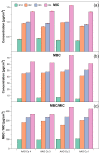Functionalised Anodised Aluminium Oxide as a Biocidal Agent
- PMID: 35955460
- PMCID: PMC9369004
- DOI: 10.3390/ijms23158327
Functionalised Anodised Aluminium Oxide as a Biocidal Agent
Abstract
In this article, we describe the antimicrobial properties of a new composite based on anodic aluminium oxide (AAO) membranes containing propyl-copper-phosphonate units arranged at a predetermined density inside the AAO channels. The samples were prepared with four concentrations of copper ions and tested as antimicrobial drug on four different strains of Escherichia coli (K12, R2, R3 and R4). For comparison, the same strains were tested with three types of antibiotics using the minimal inhibitory concentration (MIC) and minimum bactericidal concentration (MBC) tests. Moreover, DNA was isolated from the analysed bacteria which was additionally digested with formamidopyrimidine-DNA glycosylase (Fpg) protein from the group of repair glycosases. These enzymes are markers of modified oxidised bases in nucleic acids produced during oxidative stress in cells. Preliminary cellular studies, MIC and MBC tests and digestion with Fpg protein after modification of bacterial DNA suggest that these compounds may have greater potential as antibacterial agents than antibiotics such as ciprofloxacin, bleomycin and cloxacillin. The described composites are highly specific for the analysed model Escherichia coli strains and may be used in the future as new substitutes for commonly used antibiotics in clinical and nosocomial infections in the progressing pandemic era. The results show much stronger antibacterial properties of the functionalised membranes on the action of bacterial membranes in comparison to the antibiotics in the Fpg digestion experiment. This is most likely due to the strong induction of oxidative stress in the cell through the breakdown of the analysed bacterial DNA. We have also observed that the intermolecular distances between the functional units play an important role for the antimicrobial properties of the used material. Hence, we utilised the idea of the 2D solvent to tailor them.
Keywords: Fpg glycosylase; anodic aluminium oxide; antibiotics; bacterial E. coli strains; oxidative stress; surface functionalization.
Conflict of interest statement
The authors declare no conflict of interest.
Figures









Similar articles
-
Aluminium(III) Oxide-The Silent Killer of Bacteria.Molecules. 2023 Jan 3;28(1):401. doi: 10.3390/molecules28010401. Molecules. 2023. PMID: 36615599 Free PMC article.
-
The Evaluation of DHPMs as Biotoxic Agents on Pathogen Bacterial Membranes.Membranes (Basel). 2022 Feb 18;12(2):238. doi: 10.3390/membranes12020238. Membranes (Basel). 2022. PMID: 35207159 Free PMC article.
-
The Synthesis and Evaluation of Diethyl Benzylphosphonates as Potential Antimicrobial Agents.Molecules. 2022 Oct 13;27(20):6865. doi: 10.3390/molecules27206865. Molecules. 2022. PMID: 36296455 Free PMC article.
-
Mechanism of action of Escherichia coli formamidopyrimidine N-glycosylase: role of K155 in substrate binding and product release.Prog Nucleic Acid Res Mol Biol. 2001;68:223-34. doi: 10.1016/s0079-6603(01)68102-9. Prog Nucleic Acid Res Mol Biol. 2001. PMID: 11554299 Review.
-
Properties and biological functions of the NTH and FPG proteins of Escherichia coli: two DNA glycosylases that repair oxidative damage in DNA.J Photochem Photobiol B. 1993 Jul;19(2):87-96. doi: 10.1016/1011-1344(93)87101-r. J Photochem Photobiol B. 1993. PMID: 8377077 Review.
Cited by
-
Aluminium(III) Oxide-The Silent Killer of Bacteria.Molecules. 2023 Jan 3;28(1):401. doi: 10.3390/molecules28010401. Molecules. 2023. PMID: 36615599 Free PMC article.
References
-
- Quek J., Uroro E., Goswami N., Vasilev K. Design principles for bacteria-responsive antimicrobial nanomaterials. Mater. Today Chem. 2022;23:100606. doi: 10.1016/j.mtchem.2021.100606. - DOI
-
- Truong V.K., Kobaisi M.A., Vasilev K., Cozzolino D., Chapman J. Current perspectives for engineering antimicrobial nanostructured materials. Curr. Opin. Biomed. Eng. 2022;23:100399. doi: 10.1016/j.cobme.2022.100399. - DOI
-
- Hu Z.T., Chen Y., Fei Y.F., Loo S.L., Chen G., Hu M., Song Y., Zhao J., Zhang Y., Wang J. An overview of nanomaterial-based novel disinfection technologies for harmful microorganisms: Mechanism, synthesis, devices and application. Sci. Total Environ. 2022;837:155720. doi: 10.1016/j.scitotenv.2022.155720. - DOI - PubMed
MeSH terms
Substances
LinkOut - more resources
Full Text Sources

